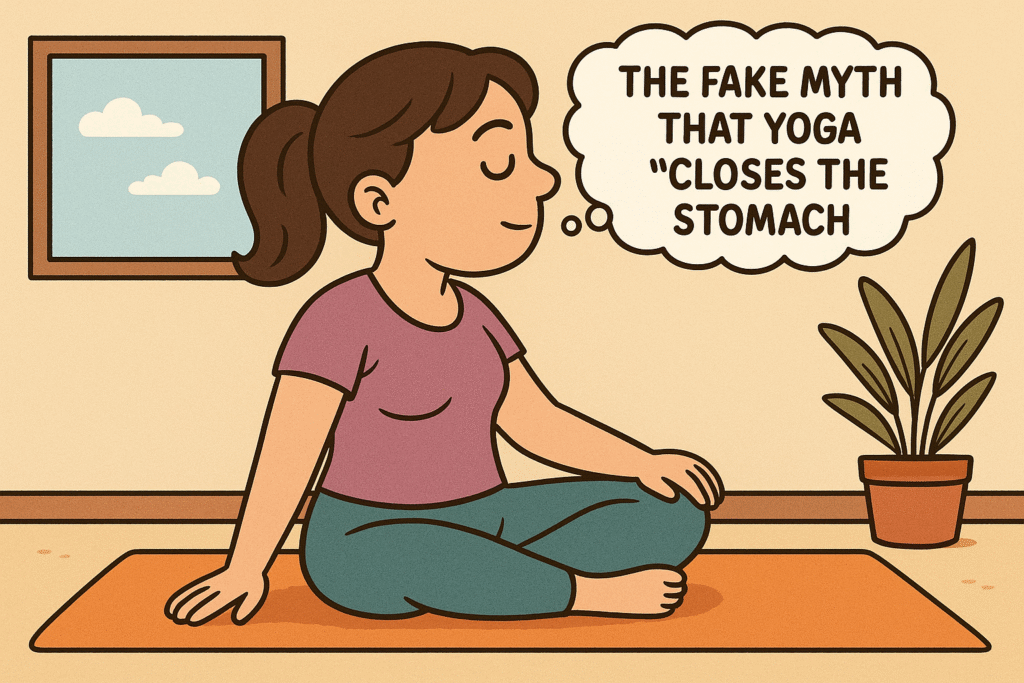Alright.
You’ve just finished a lovely flow yoga session.
Deep breathing, zen stretches, inner peace restored.
You roll up your mat with a blissful smile, wipe off some sweat…
And then it hits you —
a wave of hunger so intense it feels like your stomach is staging a rebellion.
Suddenly, your brain is tossing out bizarre questions:
“Wasn’t yoga supposed to relax me?
Why do I feel like I just sprinted uphill on an empty stomach?”
Yeah, that feeling?
It’s real.
And no, you’re not imagining things.
The fake myth that yoga “closes the stomach”

There’s this urban legend that yoga helps reduce your appetite.
Because in pop culture, yoga is associated with calm, lightness, and self-control.
So we do the math: more yoga = less hunger.
But the human body clearly missed that memo.
Because sometimes, after a tough session, you feel ready to eat your kitchen table.
And the reason isn’t just mental.
It’s in your body, your breath, your hormones.
Yoga = muscle effort, even if it doesn’t look like it
Let’s not sugarcoat it.
Yoga is physical activity.
Even if you’re not lifting weights or doing HIIT, your body is working hard.
Especially with more dynamic styles like:
- Vinyasa, where you flow smoothly from pose to pose
- Ashtanga, a tough, structured sequence
- Power Yoga, a full-blown workout
These practices engage:
- your core, always tight and bracing
- your posterior chain (glutes, back, calves)
- shoulders and arms, often in isometric holds
So even if you’re not jumping or running, you’re burning energy.
And when you burn energy, guess what?
Your body wants it back.
In the form of food.
Appetite isn’t weakness — it’s a signal
Lots of people feel guilty for being hungry after yoga, as if it’s a spiritual failure.
But real hunger is not a failure.
It’s your body’s way of saying:
“Hey, nice job on those twists and balances. Now let’s recharge the system, shall we?”
So no, you’re not greedy.
You’re not ruled by cravings.
If you’re hungry after yoga, it means your body did its job.
And it’s still doing it.
The role of hormones: it’s not just about calories
Let’s dive into the biology real quick — no boring stuff, promise.
During and after yoga, your nervous system shifts into parasympathetic mode, aka “rest and digest.”
In plain English:
- Your heart rate slows
- Blood pressure drops
- Blood flows to your digestive organs
- Hormone production stabilizes
Two big players come into play:
- Ghrelin → stimulates hunger
- Leptin → signals fullness
Yoga tends to rebalance these two.
Especially if you’ve been stressed, dieting too hard, or sleeping poorly.
In those cases, your body can become deaf to real signals.
Yoga gently opens those channels back up.
So no, it doesn’t “create” hunger out of nowhere.
It just helps you hear what was already there.
But is it all real, or partly placebo?
Great question.
Yes, there’s definitely a psychological element too.
Because yoga brings you inward.
It slows you down, focuses your breath, and tunes you in to every inch of your body.
That kind of awareness amplifies everything — including hunger signals.
But that doesn’t mean the hunger is fake.
Placebo doesn’t mean imaginary.
It’s just another route your brain uses to lead you to biological truth.
So if you feel hungry after yoga, odds are you were hungry already — you just weren’t listening.
Why yoga sometimes makes you hungrier than weightlifting

Sounds absurd, but it’s true.
I lift weights.
Squats, pull-ups, military press — all of it.
And yet some days, a 45-minute yoga session makes me hungrier than an hour at the gym.
Why?
Because strength training spikes cortisol and activates your “fight or flight” response.
So even if you burn a lot of calories, your hunger is delayed.
Yoga?
It does the opposite.
You shift into “active digestion” mode.
Your body relaxes.
Your stomach wakes up.
And appetite shows up in its purest, most honest form.
Should you eat right after yoga? And what?
Quick answer: yes, if you’re hungry.
There’s no point in resisting just because “you’re supposed to feel light after yoga.”
In fact, it’s a great time to refuel with something:
- light but complete
- high in protein and complex carbs
- hydrating
Some ideas:
- A smoothie with banana, Greek yogurt, and oats
- Whole grain toast with egg and avocado
- A quinoa bowl with veggies and chickpeas
Just skip the refined sugar and processed snacks.
Yoga gave you a gift: an active metabolism, ready to receive.
Don’t ruin it with a bag of chips.
And if the hunger feels excessive? Like black hole-level?
It happens.
Sometimes yoga triggers an outsized appetite.
When that happens, there might be something else going on:
- You’re under-eating throughout the day
- You practiced yoga on an empty stomach
- You’re in a high-training phase and yoga was the cherry on top
In those cases, don’t ignore the hunger — but approach it smartly.
Don’t just grab anything.
Use those signals to check if you’re actually fueling your body properly before class.
Morning vs evening yoga: how timing affects hunger
Timing matters.
Doing yoga in the morning, either fasted or after a light breakfast, can spark mid-morning or post-session hunger.
Your body’s used up energy after the night’s fast and kickstarted digestion.
In this case, hunger is usually mild and manageable — a good breakfast will do.
Evening yoga, though, is a different beast.
If you practice after work, slightly stressed and underfed, that parasympathetic switch might amplify the hunger you ignored all day.
And suddenly, “namaste” turns into “let’s raid the kitchen.”
Moral of the story?
It’s not just yoga that influences hunger — it’s when you do it.
Yoga and appetite on rest days: trap or superpower?
One of the most underrated effects of yoga is how it plays out on so-called “rest days.”
You know, those no-gym, no-run, no-dumbbell days.
And maybe you think: “No workout today = I’ll eat less.”
Then you do a relaxing 30-minute yoga session… and end up hungrier than leg day.
Surprise: it’s not a contradiction.
It means yoga unlocked a part of your metabolism that was “on pause” during recovery.
Your body doesn’t see rest as a break from needs.
In fact, it’s during rest that it rebuilds, restores, and requires nutrients.
Yoga, with its nervous-system balancing effect, might help you feel that need more clearly.
Don’t fight it. Respond to it wisely.
Yoga helps you spot emotional hunger vs real hunger
One of yoga’s most underrated superpowers is food awareness.
How many times do we eat out of boredom, stress, or habit?
Yoga slows you down and brings your attention to your breath — giving you a rare chance to ask:
Is this hunger real, or is it emotional reaction?
After a few weeks of regular practice, you might notice:
- Some “cravings” vanish after 5 minutes of breathwork
- Other times, you feel a real empty stomach, low energy, and brain fog: true hunger
Being able to tell the difference is a powerful skill.
And yoga gives you the tools to learn it, day by day.
Cutting calories or dieting? Can yoga and hunger coexist?
If you’re tracking macros, doing a cut, or sticking to a meal plan, the “yoga hunger spike” might stress you out.
But here’s the truth:
Yoga doesn’t sabotage your cutting phase.
Actually, it can help.
It supports hormonal balance, improves sleep quality, and reduces stress binges.
Yes, you might feel hungrier after an intense practice.
But that hunger isn’t your enemy.
It’s a refined signal — not a reckless craving.
And often, people on strict diets confuse real hunger with cheat-day temptation.
Yoga helps you stay in the middle: not denying real needs, but not reacting impulsively either.
A rare, but achievable balance.
Yoga hunger vs cardio hunger: know the difference
Post-yoga hunger hits different than what you feel after cardio or intense aerobic training.
After cardio, hunger is more mechanical — you burned a ton, you’re dehydrated, and your body wants quick sugar.
That kind of hunger often craves high-calorie, fast-absorbing foods: bread, sweets, dry carbs.
Yoga hunger?
It tends to show up more gradually.
Sometimes, you don’t even feel it until 30 minutes after the session.
And the cravings are more balanced: you want nourishment, not just something to stuff yourself with.
That’s a helpful clue for telling energy-expenditure hunger apart from neuroendocrine-regulation hunger.
The second one’s subtler — but often more authentic.
Different types of yoga = different hunger triggers
Not all yoga is created equal.
And the appetite effect varies depending on the style.
Here’s a quick guide:
- Hatha Yoga: slow, static postures with deep breathing. Helps regulate appetite during hectic days. More mental satisfaction than physical hunger.
- Vinyasa / Power Yoga: dynamic, full-body movements. Triggers appetite like functional training.
- Yin or Restorative Yoga: deeply relaxing, can awaken emotional hunger because it releases long-held tension.
- Hot Yoga (Bikram style): with intense sweat and fluid loss, the post-class hunger is often false hunger—actually thirst. Drink water first.
Knowing what kind of hunger each practice stirs up helps you respond better — avoiding overeating or unnecessary restrictions.
Yoga, appetite, and the menstrual cycle: a complex dance
For those with menstrual cycles, yoga’s effect on appetite changes dramatically depending on the hormonal phase.
During the luteal phase (second half of the cycle), metabolism naturally speeds up.
Your body needs more calories — and yoga can amplify your awareness of that need.
Many women report more hunger after intense practices during this time, because the body is already in high-energy-demand mode.
In the follicular phase, hunger tends to be steadier, and yoga often creates a longer-lasting feeling of control and lightness.
Knowing where you are in your cycle can help you avoid guilt when yoga leaves you feeling extra hungry.
It’s not wrong. It’s just physiology.
Using yoga to heal your relationship with food
Yoga isn’t just about stretching muscles and calming the mind.
It can be a powerful tool for rebuilding your relationship with food.
It teaches you how to be present, feel subtle body signals, and pause before reacting.
That can lead to:
- No more mindless eating in front of a screen
- Better awareness between true hunger and “I want something”
- Slower eating, with real satiety cues
Some people who practice yoga regularly start embracing intuitive eating — not as a trend, but because yoga retrained their internal system to actually listen.
It doesn’t happen overnight.
But it happens.
And when it does, it changes everything.
RELATED:》》》 Can too much yoga make your core weaker instead of stronger?
Final thoughts (with a mug of tea and maybe a sandwich)
So… does yoga increase appetite?
Yes.
Sometimes.
But it’s not a system glitch.
It’s a feature.
It means your body relaxed, reactivated digestion, and brought hormonal balance back online.
And now it’s asking you to complete the cycle: move, breathe… then eat.
Don’t resist just for principle.
Listen, for real.
Because yoga isn’t just about flexibility, weird poses, and incense.
It’s about learning how to feel.
And that hunger might just be your first real body-mind connection of the day.
Namaste.
Now pass the toast, please. 🥑

